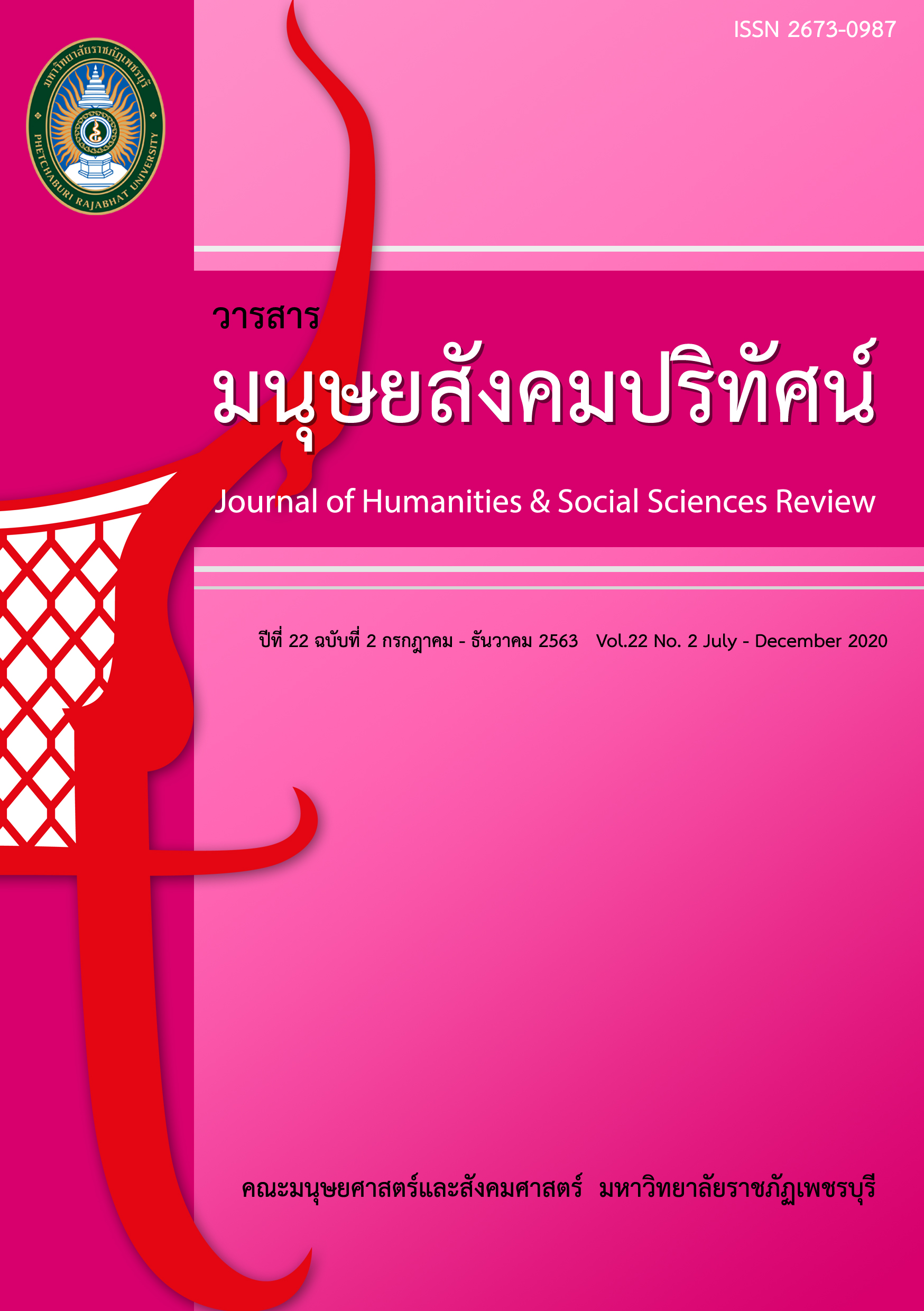The Development of Huttarak Thai Massage Innovative for Healing Headaches from Work Stress
Main Article Content
Abstract
The purposes of this article were to: 1) develop an innovation of Huttarak Thai massage for healing headache from work stress, 2) evaluate the Huttarak Thai massage innovation for healing headache from work stress. This research was a quasi-experimental study with one group of pretest-posttest design. The research target group consisted of 30 working age people in Phetchaburi province by using the purposive sampling method. The research instruments were as follows: 1) stress self-assessment form, 2) evaluation form of the client, 3) history record of massage patients, and 4) questionnaire for measuring satisfaction on Hattharak Thai massage. The data were analyzed by using frequency, percentage, paired t-test, and content analysis.
The research results were as follows:
- 1. The development of innovation of Huttarak Thai massage for healing headache from work stress was a reflexology massage using a technique of modest hand weight on the tension in the tight pressure points. The weight and range of massage in each cycle of the fingers was in 3 levels as follows: soft press for 30 percent, medium press for 50 percent, and hard press for about 70 percent, of the maximum weight that could be pressed.
2. The evaluation of Huttarak Thai massage innovation for healing headaches from work stress revealed that the target group of 30 people had higher stress level than normal, and most of them had headache in the evening from 03.00 pm. - 06.00 pm in the area of the right temporal to the occiput. After massaging 5 times, it was found that the degree of headache and distress before and after the massage were significantly different (P <0.001) by the pain after the massage was lower than before the massage. The target group was satisfied with the massage to relieve the headache; therefore, they interested in getting Thai traditional massage service again. Their impression was a method of reflexology massage that was using a technique of modest hand weight on the tension according to the pain level causing relief the tight points.
Article Details
1. Any views and comments in the article are the authors’ views. The editorial board has not to agree with those views and it is not considered as the editorial board’s responsibility. In case, there is any lawsuit about copyright infringement, it is considered as the authors’ sole responsibility.
2. The article copyright belonging to Faculty of Humanities and Social Sciences, Phetchaburi Rajabhat University are copyrighted legally. Republication must be received direct permission from the authors and Phetchaburi Rajabhat University in written form.
References
2. กระทรวงสาธารณสุข. สถาบันการแพทย์แผนไทยกรมพัฒนาการแพทย์แผนไทยและการแพทย์ทางเลือก. (2547). คู่มือประชาชนในการดูแลสุขภาพด้วยการแพทย์แผนไทย. กรุงเทพฯ: สำนักงานกิจการโรงพิมพ์องค์การสงเคราะห์ทหารผ่านศึกในพระบรมราชชูปถัมภ์.
3. กลุ่มงานวิจัยทางคลินิกด้านการแพทย์แผนไทยและสมุนไพร. (2546). ประสิทธิผลและความพึงพอใจของผู้มารับบริการด้านการนวดที่ศูนย์ส่งเสริมสุขภาพแผนไทยกระทรวงสาธารณสุข. นนทบุรี: สถาบันการแพทย์แผนไทย กรมพัฒนาการแพทย์แผนไทยและการแพทย์ทางเลือก กระทรวงสาธารณสุข.
4. จรูญลักษณ์ ป้องเจริญ. (2558). การประเมินผลการปฏิบัติราชการของบุคลากรวิทยาลัยพยาบาลในสังกัดสถาบันพระบรมราชชนก กระทรวงสาธารณสุข. วิทยานิพนธ์ปรัชญาดุษฎีบัณฑิต สาขาวิชาการบริหารการศึกษา ภาควิชาการบริหารการศึกษา บัณฑิตวิทยาลัย มหาวิทยาลัยศิลปากร.
5. ชาธิปัตย์ เครือพานิชย์ และคณะ. (2554). ผลแบบทันทีของการนวดไทยในการบรรเทาอาการปวดในผู้ป่วยปวดศีรษะจาก ความเครียดแบบ Episodic tension-type headache. วิทยานิพนธ์วิทยาศาสตรมหาบัณฑิต สาขาวิชากายภาพบำบัด คณะเทคนิคการแพทย์ มหาวิทยาลัยขอนแก่น.
6. ประพจน์ เภตรากาศ และสุรเกียรติ อาชานานุภาพ. (2555). ตำราการนวดไทยบำบัด 4. กรุงเทพฯ: มูลนิธิเพื่อเด็กพิการ.
7. พนม เกตุมาน. (2550). คลายเครียดจากการทำงาน. ค้นเมื่อ 1 มิถุนายน 2562, จาก https://www.psyclin.co.th/new_page_52.htm.
8. ยงศักดิ์ ตันติปิฎก. (2559). ตำราการนวดไทย เล่ม 1 (พิมพ์ครั้งที่ 5). กรุงเทพฯ: มูลนิธิสาธารณสุขกับการพัฒนา.
9. เรณู มีชนะ. (2544). เปรียบเทียบผลการนวดไทยประยุกต์กับการใช้ยาพาราเซตามอลในบุคคลที่มีอาการปวดศีรษะเนื่องจากความเครียด. วิทยานิพนธ์วิทยาศาสตรมหาบัณฑิต สาขาวิชาพยาบาลสาธารณสุขมหาวิทยาลัยมหิดล.
10. สถาบันการแพทย์แผนไทย กรมพัฒนาการแพทย์แผนไทยและการแพทย์ทางเลือก กระทรวงสาธารณสุข. (2547). คู่มือประชาชนในการดูแลสุขภาพด้วยการแพทย์แผนไทย. กรุงเทพฯ: สำนักงานกิจการโรงพิมพ์องค์การสงเคราะห์ทหารผ่านศึกในพรบรมราชูปถัมภ์.
11. สำนักงานสถิติแห่งชาติ. (2561). ห่วงสุขภาพคนทำงานออฟฟิศระวังป่วยออฟฟิศซินโดรม. ค้นเมื่อ 1 มิถุนายน 2562, จาก www.thaihealth.or.th.
12. สำนักงานสาธารณสุขจังหวัดเพชรบุรี. (2561). สถิติเพชรบุรีได้เก็บสถิติผู้ป่วยจากโรคปวดศีรษะระหว่างปี 2557- 2560. เพชรบุรี: สำนักงานสาธารณสุขจังหวัดเพชรบุรี.
13. อภิรดี ธรรมสรณ์. (2560). การศึกษาผลของการนวดแผนไทยต่อคุณภาพชีวิตด้านสุขภาพของกลุ่มคนวัยทำงาน. วิทยานิพนธ์วิทยาศาสตรมหาบัณฑิต สาขาวิชาวิทยาการชะลอวัยและฟื้นฟูสุขภาพ วิทยาลัยการแพทย์บูรณาการ มหาวิทยาลัยธุรกิจบัณฑิตย์.
14. อุไร นิโรธนันท. (2539). ผลการนวดต่อความเจ็บปวดและความทุกข์ทรมานในผู้ป่วยมะเร็ง. กรุงเทพฯ:มหาวิทยาลัยมหิดล.
15. Bloom, B.S., et al. (1971). Handbook on formative and summative evaluation of student learning. New York: Mc Graw-Hill Book.
16. Johnson, M. (1977). Assessment of clinical pain. In A. Jacox (Ed.). Pain: Source book for nurse and other health professionals. (pp. 139-166). Boston: Little bow and company.


